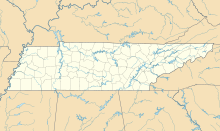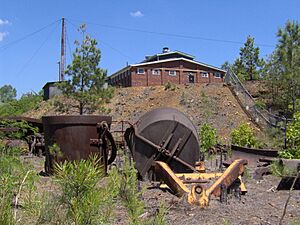Burra Burra Mine (Tennessee) facts for kids

Burra Burra Mine collapse site
|
|
| Location | |
|---|---|
| Location | Ducktown, Tennessee |
| Coordinates | 35°2′7″N 84°22′46″W / 35.03528°N 84.37944°W |
| Production | |
| Products | Copper |
| History | |
| Active | 60 |
| Closed | 1959 |
|
Burra Burra Mine Historic District
|
|
| Lua error in Module:Location_map at line 420: attempt to index field 'wikibase' (a nil value). | |
| Built | 1899 |
| NRHP reference No. | 83003059 |
| Added to NRHP | 1983 |
The Burra Burra Mine was a large copper mine in Ducktown, Tennessee. It's in the southeastern part of the United States. This mine was named after a famous mine in Australia.
The Burra Burra Mine is located in a special area called the Copper Basin. For 60 years, from 1899 to 1959, it dug up over 15 million tons of copper ore! Today, some of the old mine buildings are protected as a historic site. You can also visit the Ducktown Basin Museum right there. It's a Tennessee State Historic Site.
Mining in the Copper Basin, including the Burra Burra Mine, happened from 1850 to 1987. The copper ore they dug up contained sulfur. To get rid of the sulfur, they cut down many trees and burned the ore. This process released a lot of sulfuric acid into the air. This pollution, along with cutting down trees, damaged over 32,000 acres (about 13,000 hectares) of the basin. The land became eroded and almost lifeless. But don't worry! After many years of planting new trees and plants, the area is now recovering.
Contents
Where is the Burra Burra Mine?
The Burra Burra Mine is in the middle of the Copper Basin. This area is also known as the Ducktown Basin. It's a wide valley in the southern Appalachian Mountains. The basin is close to where Tennessee, North Carolina, and Georgia meet.
Ducktown, where the mine is, sits in the center of the Copper Basin. It's near the crossing of Tennessee State Route 68 and U.S. Route 64. The mine is also about 2 miles (3.2 km) north of Copperhill. This town is close to the Tennessee-Georgia border. The mine is about 1,798 feet (548 meters) above sea level.
A Look at the Mine's History
The Copper Basin used to be part of Cherokee lands. In 1836, the Cherokee people gave control of the basin to the U.S. government. The area then became part of the Ocoee District. Most Cherokees were forced to leave in 1838. However, some stayed and later helped with building roads and mining.
When Was Copper First Found?
Copper was first found in the Copper Basin in 1843. This discovery happened on a hill southwest of where the Burra Burra Mine would later be built. In 1860, several small mining companies in the basin joined together. They formed the Burra Burra Copper Company. A mining engineer named Julius Raht led this new company.
Building the Burra Burra Mine
In 1899, the Tennessee Copper Company bought most of the mines in the Copper Basin. They built a smelter, which is a factory for melting ore, in Copperhill. Then, they started building the Burra Burra Mine in Ducktown. The company used a method that released a lot of sulfur dioxide into the air. This gas killed almost all the plants in the central basin.
The Burra Burra Mine became the most successful mine in the Copper Basin. When it closed in 1958, its main shaft was over 2,400 feet (730 meters) deep. This made it one of the deepest vertical mine shafts in North America! Even after the Burra Burra Mine closed, other mining operations continued in the basin.
The Burra Burra Mine Today
Mining in the Copper Basin stopped completely in 1987. This happened when the Tennessee Chemical Company, which took over from Tennessee Copper, went out of business.
How the Land Recovered
To help the land recover, over 16 million trees have been planted. Special grass that can grow in acidic soil has also been planted. A 300-acre (1.2 km2) area around the Burra Burra Mine was left as it was. This area serves as a reminder of how the entire central basin once looked.
Visiting the Mine Site
The state of Tennessee bought the Ducktown Museum and Burra Burra Mine in 1988. Local people helped a lot to set up the museum. Many of them still feel very proud of the mining history.
Ten of the mine's original buildings are still standing. These include the hoist house, boiler building, and machine shops. The old engineers' office building is now home to the Ducktown Basin Museum. You can see many old machine parts, tools, and other items used in mining displayed around the museum grounds. From the museum's parking lot, you can look down into a huge sinkhole. This sinkhole is now filled with water and was formed when part of the Burra Burra Mine collapsed.



